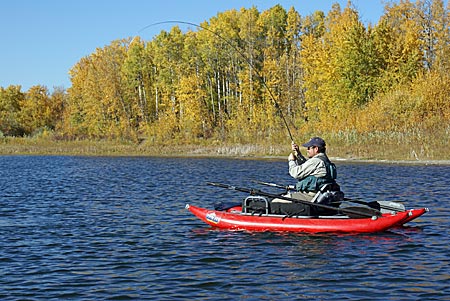| Tying and Fishing Chironomid Larva |
 |
| Bloodworm patterns are excellent choices during the fall. | After slowly cruising the shoreline areas of the lake I finally found a spot that appeared promising. My chosen spot was a small shoal extending approximately 50 feet from shore. I chose to anchor myself parallel to the steep drop off in about 18 feet of water. Due to the gin clear water the fish would not be on the shoal but cruising rather leisurely along the drop off making the odd foray into the shallows. Experience had taught these fish that prolonged exposure on these shoals was a dangerous proposal. Ospreys, Eagles and Loons had all taken their fair share of fish. I tied on one my favorite patterns for early spring, prepared my dry line and leader and made my first cast of the day. I glanced at my watch, observing the position of the sweep second hand. I had roughly one minute I figured, so I busied myself readying the boat further for the days fishing. Picking up my rod I removed any slack in the line and began a very slow hand twist retrieve. About twenty seconds into the retrieve I felt a very subtle take. Instinctively I raised my rod. My line erupted, the loose coils from the boat floor raced through the guides, disappearing into the blue green depths of the lake. After a number of spectacular jumps and two runs into my backing the 4lb Kamloops Rainbow slid quietly into my waiting net. I removed the barbless fly from her mouth, and she returned back to her watery world. A fish on my first, cast what a way to start the day. I quickly recast my line quartering it slightly towards the deeper water and let the slight drift of the wind swing my fly back around the boat. This time I did not even get a chance to retrieve the fly. My line just started to peel off of my reel. Once again after a spirited battle I returned the rested fish to the lake. The fly pattern I caught these magnificent fish on was not a Woolly Bugger, leech or dragon fly nymph pattern but rather a simple chironomid larva pattern, commonly referred to as a bloodworm in western Canada.
In most of North America they known as midges, in the United Kingdom they are buzzers but in Western Canada we usually call them Chironomids. There are over 3,500 known species of chironomids. They are the number one item on the menu of trout in productive stillwaters. Chironomids belong to the order Diptera and these two winged insects are the most important insect for the stillwater fly fisher to imitate. From my own records the pupa and larva of these insects account for over 50% of the total food intake of trout in the nutrient rich lakes of south central British Columbia. Similarly productive lakes also exist throughout the western United States. Chironomids are tolerant of a wide range of water conditions and it is safe to say that any productive lake or pond will contain good numbers of these insects. Yet for most they are difficult to imitate as the patience required to fish them often undermines the confidence of the angler. There is fishing information available upon the adult and pupal stages of the chironomid but little or no information available on larval techniques. Yet this is an important stage to imitate as it is certainly one the trout does not pass up. Some have said that the larval stage is not worth imitating, and for those people they are missing out on some great fishing. At certain times of the year only chironomid larva patterns will consistently catch fish. The lowly chironomid larva does not seem to get the credit it deserves.
To view the rest of this article, please login or join now for free!
|
|



